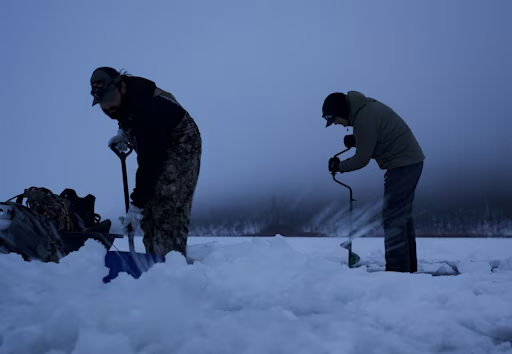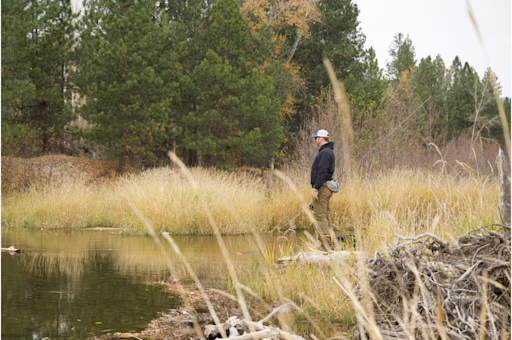Fall fishing tips with Fishbrain
Learn which Fishbrain features can be used specifically for the changing fishing conditions and migrating species in fall.
Share this article

Fall is officially here, marking the changes in weather and in your fishing habits. This is a great time to fish for specific species and travel to specific destinations, but new tactics and strategies need to be implemented compared to summer.
Fishbrain offers the fishing data, forecasts and location info needed for you to smoothly transition your fishing from summer to fall.
Below are some of the key features Fishbrain offers to help you locate fish and deal with changing environments this fall.
Watch your water levels

Fall storms can make or break a fishing trip. Anglers casting for migratory species like salmon and steelhead, need storms to fill rivers, pushing schools of fish upstream, toward their spawning grounds. Smallmouth and trout anglers may like a nice boost in water levels, or the addition of a little color from sediment, but too much can blow a waterway out for days and in places like the Pacific Northwest for weeks.
Regardless of what you need from a storm, you need to pay attention water levels. Monitor them closely for any flowing waterway you fish and watch the volume, levels and temperatures. You can plan your days accordingly, by looking for spikes and drops and warming and cooling patterns in the waters, which give you insight into fish behavior.
Access like never before

Fish are moving during fall. Redfish are moving closer to the creeks, steelhead are starting their perilous journey upstream and other species, like trout and smallmouth, are moving to different river sections as water temps change and insect hatches start decreasing. This increase in activity can have you looking for fish in brand new sections of water you've never looked at before. You can quickly find yourself looking at a new piece of land, wondering if you're allowed to walk across it, or not, to get to the water.
Nor more wondering. Now you can fish with confidence, when you turn on the Parks and Government Lands layer on the Fishbrain Map. Once on, the layer shades areas a light yellow that offer possible access, which are either state, or federally owned lands. Tap on the shaded parcel to find how large it is and what type of land it is. If you're unsure about access laws, just do a quick double check ion your state's laws then start fishing these once seemingly inaccessible spots.
Filter your Map

Migration and spawn are a large factor to consider when targeting fall species. Salmon, brown trout, redfish and stripers are just a few popular species that travel great distances in search of either spawning grounds, or warm water and food. Needless to say, your summer spots will not yield the same results in fall.
Your Fishbrain map is key for studying exact catch locations and catch data, but as we mentioned above, summer catch locations do you little good in the fall.

To find accurate catch data specific to the fall, fiter the catch data to only show specific months and species. This will show you where other users are targeting species as they travel up river systems from lakes and the ocean, or where along the coast they are migrating.
Filter your search to find how far the striper migration usually ends up down the East Coast this time of year, or how far up the Sacramento River the chinook are running.
Even more helpful than filtering your catches is looking for brand new catches for the most real time data. Regardless of the filter you set, new catches made within the last two weeks will appear as orange waypoints. These points are crucial for finding the most up to date spawn and migration patterns.
Find what's working

After filtering your map to see seasonal catches, make sure and browse catch data provided by users. Just because you are fishing the right place at the right time, doesn’t mean you have the right gear. Fall fish often require fall baits and lures and by looking at provided catch data, you can understand which baits are popular this time of year. Whether it's sardines and a flatfish for stripers, a BioBait shad for bass, or a Clouser minnow for trout on the fly, you can find the perfect lure to match the rest of your catch data.
Watch the Forecast

One of the main draws of fall fishing is an increase in viable fishing times. The cool weather means fish will be more active during mid day, not just early mornings and evenings. In fact you may actually find more success by waiting to fish later in the day, as the sun warms chilly water temps up enough to illicit fish activity.
Your FIshbrain forecast is key, here. Pay close attention to warming temps and heat of the day on cool and chilly mornings by tapping the forecast for your area. Many species like bass, bluegill and crappie, will remain sluggish until the sun comes out to warm them. The Forecast helps you time your trips perfectly this way, by not struggling during these low activity level periods. Other species, like trout, prefer the cool weather, but will still have a threshold of cold weather before they start feeding.

Mid day warm weather can also trigger bug hatches which trout will key in on and you can time these hatches often by knowing when the day begins to warm, or if the sun will come out from behind the clouds on overcast days.
Fall Saltwater

Tides can be a tricky factor to deal with and they can get even trickier near the fall equinox. At this time, the sun’s pull on the earth is extra strong and this also affects your tide. It’s important for salt anglers to monitor these changes and they can do so right on the Fishbrain App.
Access your tide data by hovering over the area you are fishing on your map and then tapping the sun and cloud icon on the left of your screen. From there scroll to the bottom of your screen to check a full tidal chart. You can then scroll left and right to check the tides for later times and dates.

Another factor the salt angler needs to prepare for is storms and waves. The deeper we get into fall and the closer to winter, the greater the likelihood of storms. From the same Forecast page on the Fishbrain App you can even get real time wave height data. This is just as important for the wading surf angler and the boat angler and can make all the difference on your day on the water.
There is still plenty of time to fish this fall. Make sure and get out on the water for the last casts that 2021 has to offer. Your Fishbrain App is here to make the most of your fishing and hopefully end the year with some personal bests.
Now let's go fishing. We'll bring the best fall lures.
If you haven't experienced the #1 fishing app worldwide, make sure and check out Fishbrain to see all the fish data, fishing spots, weather conditions you've been missing out on plus much more.

Download the Fishbrain app and access the best fishing spots in your area
Related blog posts
Master the hardwater season with advanced ice fishing tips . Learn how to find fish faster, refine your search and adjust presentations to catch more fish all winter long.

Your guide to Victoria’s best fish to catch in rivers, lakes, and coastal waters. Learn prime species, fishing tips, and key regulations

Learn how fish adapt as water temperatures cool from autumn to winter, including changes in behavior, metabolism, and habitat that help them survive.




